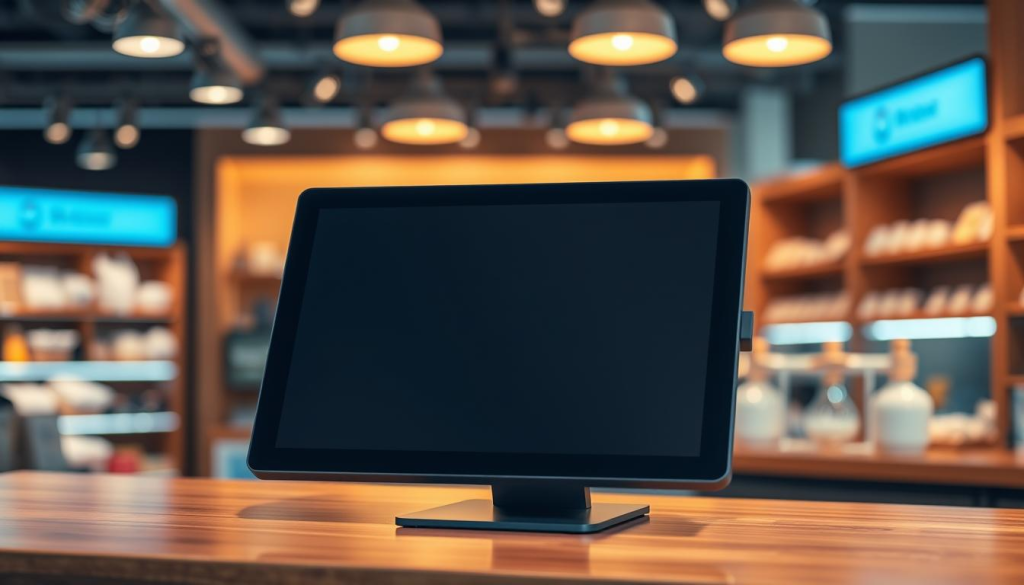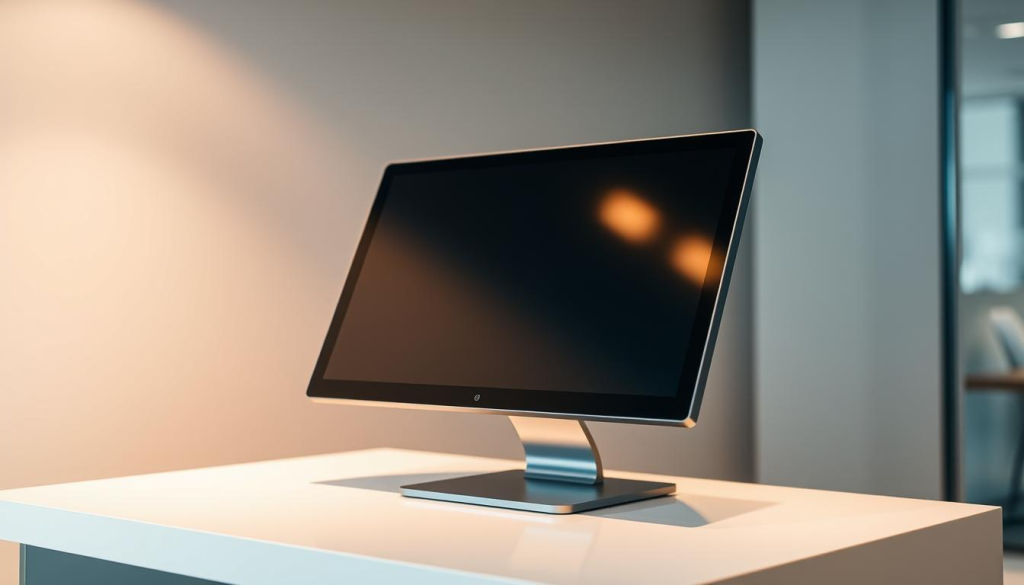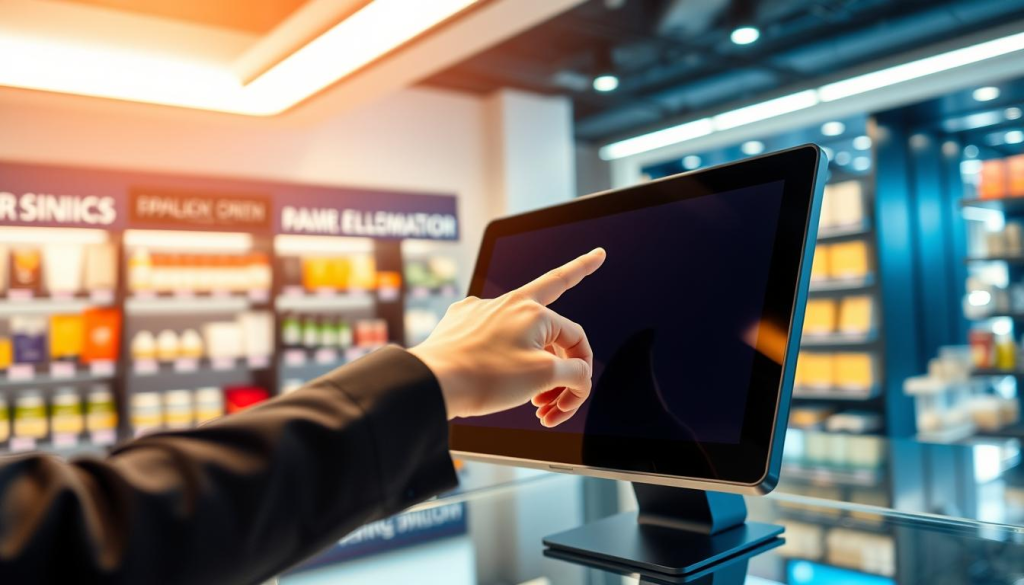In today’s fast-paced retail world, a POS touch screen monitor is essential. It connects businesses with customers, making transactions smooth and improving shopping experiences. Finding the best POS touch screen monitors can boost efficiency and customer happiness.
This article looks at different options in the market. It covers important features, price comparisons, and setup tips. Whether for a busy café or store, knowing these details helps make smart choices. Modern POS touchscreen displays can make operations faster and service better.

Key Takeaways
- Mobile POS systems improve operational efficiency and customer satisfaction.
- Self-service solutions reduce wait times and enhance order accuracy.
- Durability features are essential for POS monitors in busy environments.
- Key considerations for choosing a monitor include screen size and touch technology.
- Compatibility with POS software is critical for smooth integration.
- Modern displays support higher resolutions and multitouch functionality.
- Pricing varies significantly, making comparison key for value.
Introduction to POS Touch Screen Monitors
POS touch screen monitors change the way we handle sales. They make transactions easier and more interactive. With touch screen point of sale monitors, businesses can connect to web-based platforms easily. This helps all kinds of businesses work better.
Using a POS touch screen monitor can make transactions up to 30% faster. They support mobile payments and keep inventory up to date. About 70% of retailers now use touch screens to make things smoother.
The POS touch screen monitor software is easy to use. It has big buttons for quick orders. This makes orders 25% faster and cuts down on mistakes by 50%. Happy customers mean better business.
Portable touch screens make things more efficient and accurate. They help manage inventory better, with up to 40% more accuracy. As more businesses use these, customer service and sales get even better.
The Importance of a Quality POS Touch Screen Monitor
A quality POS touch screen monitor is key for business success, mainly in retail. It makes processes smoother, speeds up transactions, and boosts accuracy. This leads to better staff performance and happier customers.
The best POS monitor has a multi-touch feature. This lets staff interact with the screen in many ways at once. It makes training new employees faster and reduces mistakes during sales.
Interactive product catalogs on these monitors help businesses sell more. They improve the shopping experience, which can increase sales. This makes them a smart investment for any business.
Multi-touch systems also make data entry easier, cutting down on errors. Some models even let you capture signatures and gather customer feedback. This makes data collection more complete.
Using multi-touch technology can greatly improve customer satisfaction. It meets today’s mobile technology needs. It also helps businesses understand customer behavior and trends better.
Key Features to Look for in a POS Touch Screen Monitor
Knowing what makes a good pos touch screen monitor is key for your retail business. When you’re looking for the best, you need to check several important features. These include how well it works, how long it lasts, and how it performs overall.
Screen Size and Resolution
The size of the screen on a pos touchscreen display is very important. It affects how easy it is to see and use during sales. Sizes range from 10 to 21 inches, and higher resolutions mean clearer images.
A bigger screen can help customers interact more easily. And a high resolution makes everything look sharper. This makes shopping better for everyone.
Durability and Build Quality
Because they’re used a lot in busy stores, durability is a must for pos touch screen monitors. Look for screens that can resist scratches and are protected against spills. This is very important in places where food is handled.
Things like 6H hardened tempered glass or Gorilla glass can make a monitor last longer. They help it work well even when it’s used a lot.
Touch Technology Options
There are two main types of touch technology: resistive and capacitive. Capacitive screens are more responsive and work well in places where quick input is needed. Resistive screens are cheaper and work with gloves or styluses, making them good for certain jobs.
Knowing about these options helps businesses pick the right screen for their needs.
| Feature | Resistive Touch | Capacitive Touch |
|---|---|---|
| Responsiveness | Lower | Higher |
| Cost | More Affordable | Generally Higher |
| Glove Compatibility | Yes | No |
| Durability | Less Durability | More Durable |
| Common Uses | Industrial, Retail | Retail, Restaurants |
Top POS Touch Screen Monitors in the Market
Looking for a top pos touch screen monitor? The market has many great options. Each brand has special features for different business needs. This means retailers can find the perfect match for their operations.
Square POS Touch Screen Solutions
Square is a top pick for small businesses. It offers a user-friendly, affordable pos touch screen monitor system. Prices start at free for the basic plan, going up to $60 monthly for more features.
This system is great for various retail setups. It’s easy to use and handles payment processing well.
Shopify’s POS Touch Screen Monitors
Shopify is perfect for businesses with online and in-store sales. Its pos touch screen monitor system supports sales across different channels. Plans start at $29 monthly.
This flexibility helps manage inventory and sales well. It suits businesses with different customer volumes and needs.
Lightspeed POS Display Options
Lightspeed is known for its strong inventory management. It’s great for retailers with lots of products. Prices start at $69 monthly.
Its pos touch screen monitor system helps track inventory and report sales. It’s perfect for high-volume operations, boosting overall efficiency.

Comparison of Pricing and Features
Looking at the pos touch screen monitor price shows big differences. Prices start at $150 for basic models and can go over $4,000 for the best ones. Monthly fees for POS software range from $0 to $100. This depends on the software’s features and the type of business.
Choosing the best pos monitor means looking at more than just the upfront cost. Ongoing fees, like per-location and per-register charges, are also important. For example, Square offers a free POS system but charges 2.6% plus 10 cents per transaction. Lightspeed’s prices have gone up, making it key to keep checking if the cost matches your business needs.
| POS Provider | Monthly Fee Range | Hardware Cost | Transaction Fees |
|---|---|---|---|
| Square | $0 – $100 (free options available) | $150 – $3,000 (for terminals) | 2.6% + $0.10 per transaction |
| Lightspeed | $69 – $299 | $200 – $4,000 | Variable, typically higher than Square |
| Shopify | $0 (with subscription) – $299 | $200 – $1,500 | 2.9% + $0.30 for online sales |
| Clover | $0 – $300+ | $300 – $4,000 | 2.3% + $0.10 depending on plan |
| Loyverse | $0 (free tier available) | $50 – $800 | Variable, based on credit card processors |
Businesses should think about what they really need before buying. For example, Lightspeed’s advanced analytics tools might be worth the extra cost for better inventory management. On the other hand, Loyverse might be a good choice for those with simpler needs.
Setting Up Your POS Touch Screen Monitor
Setting up a POS touch screen monitor needs careful thought to boost efficiency and improve customer experience. It’s key to make sure it works well with your current POS software to avoid service issues. Brands like Elo offer software that makes integration smoother.
Businesses must check that all parts work together, like if your POS system needs a specific operating system like Windows.
Compatibility with POS Software
Matching your POS touch screen monitor with the right software is important. A good match means faster transactions and happier customers. Monitors from top brands often come ready to go or have simple setup for software like Shopify and Lightspeed.
Connectivity Options Overview
Connectivity is vital for setting up your POS touch screen monitor. You need enough ports for things like barcode scanners and receipt printers. This setup makes your business run smoothly, allowing for quick payments and better service.

Benefits of Using a POS Touch Screen Monitor
Using a POS touch screen monitor brings many benefits to retail businesses. These devices make shopping faster and more efficient. They improve how businesses run, leading to happier customers and better performance.
Enhanced Customer Experience
One big advantage of POS touch screen monitors is how they speed up transactions. They can make checkout up to 30% faster. This means customers spend less time waiting, which makes them happier.
Studies show a 15% boost in customer satisfaction when retailers use touch screens. The easy-to-use interfaces make shopping smoother. This creates a better shopping experience for everyone.
Increased Operational Efficiency
POS touch screen monitors also make businesses run better. Old systems can be big and hard to manage. But touch screens are sleek and easy to use, freeing up staff to help customers more.
They also help track employee work and performance, saving about 50% of administrative time. Plus, they cost less to maintain, up to 50% less than old systems. This is because they’re durable and easy to clean.
Conclusion
Choosing the best POS touch screen monitor is key for businesses to succeed today. The right POS touchscreen display makes operations smoother and improves customer experience. It speeds up transactions and adds interactive features.
When picking a POS touchscreen monitor, consider size, durability, and touch technology. This helps businesses find the perfect fit for their needs.
Adding portable touchscreen monitors to POS systems needs careful planning. Make sure the software works well and train staff properly. This ensures smooth operations and happy users.
Using advanced touch technologies like projected capacitive touch can make the interface more responsive. This helps businesses adapt to different environments.
Using a POS touchscreen monitor to its fullest can really engage customers. It cuts down wait times and makes shopping better. This technology boosts profits and helps businesses grow in a changing market.
FAQ
What are the advantages of using a POS touch screen monitor?
POS touch screen monitors make transactions faster and easier. They also help improve how your business runs. Features like mobile payments and inventory management are big pluses.
How do I choose the best POS monitor for my business?
Think about the screen size, how durable it is, and the touch technology. Make sure it works with your current POS software. Also, consider your budget and what you need for your business.
What is the typical price range for POS touch screen monitors?
Prices vary a lot. Basic systems might be free, but full-featured ones can cost about $120 a month. This depends on what features and software you need.
What are the main differences between resistive and capacitive touch technology?
Resistive screens are good for places where you might wear gloves or use a stylus. They’re more affordable. Capacitive screens are better for fast environments because they’re more responsive.
Can I integrate a POS touch screen monitor with my existing software?
Yes, it’s important to pick a monitor that works well with your current software. Make sure it has USB, HDMI, and VGA ports for easy connection.
What features should I look for in a POS touch screen monitor?
Look for a good screen size and resolution. It should be durable and have scratch-resistant screens. Also, check the touch technology and connectivity options for things like barcode scanners.
How do I maintain my POS touchscreen display?
Clean the screen regularly with the right cleaners. Protect it from spills and impacts. Keep the software up to date for the best performance and security.
What are some popular brands of POS touch screen monitors?
Brands like Elo, Square, Shopify, and Lightspeed are well-known. They offer a range of monitors for different retail needs.